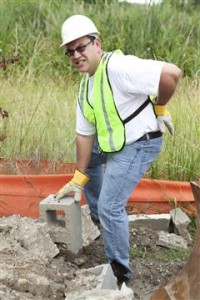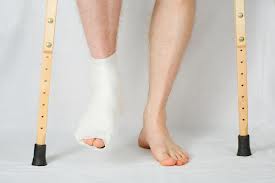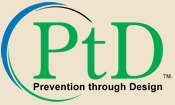 The investigative report should answer six key questions: who, what, when, where, why, and how. Fact should be distinguished from opinion, and both should be presented carefully and clearly. The report should include thorough interviews with everyone with any knowledge of the incident. A good investigation is likely to reveal several contributing factors, and it probably will recommend several preventive actions.
The investigative report should answer six key questions: who, what, when, where, why, and how. Fact should be distinguished from opinion, and both should be presented carefully and clearly. The report should include thorough interviews with everyone with any knowledge of the incident. A good investigation is likely to reveal several contributing factors, and it probably will recommend several preventive actions.
Tag: safety at work
Incident Investigative Should Answer Six Key Questions
 Six key questions should be answered: who, what, when, where, why, and how. Fact should be distinguished from opinion, and both should be presented carefully and clearly. The report should include thorough interviews with everyone with any knowledge of the incident. A good investigation is likely to reveal several contributing factors, and it probably will recommend several preventive actions.
Six key questions should be answered: who, what, when, where, why, and how. Fact should be distinguished from opinion, and both should be presented carefully and clearly. The report should include thorough interviews with everyone with any knowledge of the incident. A good investigation is likely to reveal several contributing factors, and it probably will recommend several preventive actions.
You will want to avoid the trap of laying sole blame on the injured employee. Even if injured workers openly blame themselves for making a mistake or not following prescribed procedures, the accident investigator must not be satisfied that all contributing causes have been identified. The error made by the employee may not be even the most important contributing cause. The employee who has not followed prescribed procedures may have been encouraged directly or indirectly by a supervisor or production quotas to “cut corners.” The prescribed procedures may not be practical, or even safe, in the eyes of the employee(s). Sometimes where elaborate and difficult procedures are required, engineering redesign might be a better answer. In such cases, management errors — not employee error — may be the most important contributing causes.
All supervisors and others who investigate incidents should be held accountable for describing causes carefully and clearly. When reviewing accident investigation reports, the safety department or in-house safety expert should be on the lookout for catch-phrases, for example, “Employee did not plan job properly.” While such a statement may suggest an underlying problem with this worker, it is not conducive to identifying all possible causes, preventions, and controls. Certainly, it is too late to plan a job when the employee is about to do it. Further, it is unlikely that safe work will always result when each employee is expected to plan procedures alone.
Fatal Falls at Work
 In 2013, falls to lower level accounted for 574 fatal work injuries. Of the cases where height of fall was known (466 cases), 3 out of every 5 were falls of 20 feet or less. Only one in five cases involved falls from more than 30 feet. In fact one in ten cases involved falls of less than 6 feet.
In 2013, falls to lower level accounted for 574 fatal work injuries. Of the cases where height of fall was known (466 cases), 3 out of every 5 were falls of 20 feet or less. Only one in five cases involved falls from more than 30 feet. In fact one in ten cases involved falls of less than 6 feet.
Source: U.S. Bureau of Labor Statistics, U.S. Department of Labor, 2014
Age of Worker Fatalities
Materials Handling: Heavy Lifting
 Lifting heavy items is one of the leading causes of injury in the workplace. In 2001, the Bureau of Labor Statistics reported that over 36 percent of injuries involving missed workdays were the result of shoulder and back injuries. Overexertion and cumulative trauma were the biggest factors in these injuries.
Lifting heavy items is one of the leading causes of injury in the workplace. In 2001, the Bureau of Labor Statistics reported that over 36 percent of injuries involving missed workdays were the result of shoulder and back injuries. Overexertion and cumulative trauma were the biggest factors in these injuries.
When employees use smart lifting practices and work in their “power zone,” they are less likely to suffer from back sprains, muscle pulls, wrist injuries, elbow injuries, spinal injuries, and other injuries caused by lifting heavy objects.
- Weight of Objects
- Awkward Postures
- High-Frequency and Long-Duration Lifting
- Inadequate Handholds
- Environmental Factors
via Ergonomics eTool: Solutions for Electrical Contractors – Materials Handling: Heavy Lifting.
Health Care Workers
 Healthcare is the fastest-growing sector of the U.S. economy, employing over 18 million workers. Women represent nearly 80% of the healthcare work force. Health care workers face a wide range of hazards on the job, including needlestick injuries, back injuries, latex allergy, violence, and stress. Although it is possible to prevent or reduce healthcare worker exposure to these hazards, healthcare workers continue to experience injuries and illnesses in the workplace. Cases of nonfatal occupational injury and illness among to healthcare workers are among the highest of any industry sector.
Healthcare is the fastest-growing sector of the U.S. economy, employing over 18 million workers. Women represent nearly 80% of the healthcare work force. Health care workers face a wide range of hazards on the job, including needlestick injuries, back injuries, latex allergy, violence, and stress. Although it is possible to prevent or reduce healthcare worker exposure to these hazards, healthcare workers continue to experience injuries and illnesses in the workplace. Cases of nonfatal occupational injury and illness among to healthcare workers are among the highest of any industry sector.
via CDC – Health Care Workers – NIOSH Workplace Safety and Health Topic.
The Hidden Costs of Accidents at Work
 Accidents are more expensive than most people realize because of the hidden costs. Some costs are obvious — for example, Workers’ Compensation claims which cover medical costs and indemnity payments for an injured or ill worker. These are the direct costs of accidents.
Accidents are more expensive than most people realize because of the hidden costs. Some costs are obvious — for example, Workers’ Compensation claims which cover medical costs and indemnity payments for an injured or ill worker. These are the direct costs of accidents.
But what about the costs to train and compensate a replacement worker, repair damaged property, investigate the accident and implement corrective action, and to maintain insurance coverage? Even less apparent are the costs related to schedule delays, added administrative time, lower morale, increased absenteeism, and poorer customer relations. These are the indirect costs — costs that aren’t so obvious until we take a closer look.
Studies show that the ratio of indirect costs to direct costs varies widely, from a high of 20:1 to a low of 1:1. OSHA’s approach is shown here and says that the lower the direct costs of an accident, the higher the ratio of indirect to direct costs.
Recommendations to Prevent Workplace Violence
 The following are seven useful recommendations to help you prevent and resolve conflicts that could emerge within your organization.
The following are seven useful recommendations to help you prevent and resolve conflicts that could emerge within your organization.
Adopt and promote a prevention and reparation policy against harassment.
- Create a prevention policy involving each level of the organization: management, employees and union representatives. For further assistance, feel free to consult the sample policies found on this website.
- Make sure information about the new policy is widely distributed, that all employees know the policy and encourage everyone to make it their own.
- Put a system in place to record all acts of violence by creating, for example, an Event Report Form.
- Set up procedures to handle complaints impartially, confidentially and quickly. These should include measures to prevent any recurrence of harassment and other types of workplace violence. It is critical to ensure that the victim feels safe against retaliation and has the right, if needed, to be represented when interviewed by an independent and qualified investigator. Keep in mind that, in this case, lodging a formal complaint is not always the best solution since it often involves lengthy delays.
- And finally, establish measures to support the victims and the alleged perpetrators.
Establish clear codes of conduct.
- Define and communicate a clear code of conduct like ‘Zero-tolerance’ with respect to moral harassment and other types of workplace violence.
- Make sure all employees know your organization’s code of conduct. These measures should reflect your organization’s commitment to preventing and responding to external acts of violence.
- Try to reduce and even eliminate behaviour that contravenes your code of conduct by exercising dissuasion and enforcing sanctions.
Organize awareness and training sessions.
- Take time to organize and provide access to awareness and training sessions on the prevention of workplace violence.
- Open the necessary lines of communication to achieve your prevention objectives.
Do not allow conflicts to escalate into harassment or acts of violence.
- Monitor the training of work teams. Working in teams highlights interpersonal relations and may give rise to some situations that could cause tension among people.
- Deal with conflicts swiftly, and from the moment they begin. Harassment and violence stem from unresolved conflicts that fester. They can degenerate and turn the workplace into a hostile environment and create negative occurrences that are violent and costly.
Set up effective lines of communication.
- Open effective lines of communication, because aggressors thrive on the silence of victims and witnesses. Communication is a key factor in the well-being of employees.
- Promote communication and regular meetings of your work teams. Strong lines of communication will not only rally employees against violence, they also reduce the risk of workplace violence by defusing tensions and clarifying situations and misunderstandings.
Pay special attention to the quality of relationships among members of a work team.
- Ensure that work is meaningful for each worker.
- Manage work teams to help prevent and resolve violent situations.
Encourage the acceptance of individual differences.
- Communicate the idea that the strength of a team resides in individual differences (We need each other to make a winning team. The “differences” in each team member makes the strength of the team and enhances the team’s performance.)
- Where possible, plan social or training activities that help team members get to know each other and discover each other’s strengths and weaknesses, from a standpoint of openness to such differences and of acceptance of each team member’s willingness to improve interpersonal relations.
via Basic recommendations for preventing violence in the workplace.
Foot Comfort and Safety at Work
 Why is foot comfort important?
Why is foot comfort important?
As the old saying goes, “When your feet hurt, you hurt all over.”
There are two major categories of work-related foot injuries. The first category includes foot injuries from punctures, crushing, sprains, and lacerations. They account for 10 percent of all reported disabling injuries. The second group of injuries includes those resulting from slips, trips and falls. They account for 15 percent of all reported disabling injuries. Slips and falls do not always result in a foot injury but lack of attention to foot safety plays an important role in their occurrence.
These two categories of foot injuries, however, do not exhaust the whole range of foot problems at work. There are also other conditions such as calluses, ingrown toenails or simply tired feet that are common among workers. Although these may not be considered as occupational injuries in the strictest sense, they can have serious consequences for health and safety at the workplace. They cause discomfort, pain and fatigue. Fatigue sets up the worker for further injuries affecting the muscles and joints. Also, a worker who is tired and suffering pain is less alert and more likely to act unsafely. An accident of any kind may result.
Prevention through Design
 One of the best ways to prevent and control occupational injuries, illnesses, and fatalities is to “design out” or minimize hazards and risks. NIOSH leads a national initiative called Prevention through Design (PtD). PtD’s purpose is to promote this concept and highlight its importance in all business decisions.
One of the best ways to prevent and control occupational injuries, illnesses, and fatalities is to “design out” or minimize hazards and risks. NIOSH leads a national initiative called Prevention through Design (PtD). PtD’s purpose is to promote this concept and highlight its importance in all business decisions.
via CDC – Prevention through Design – NIOSH Workplace Safety and Health Topic.

